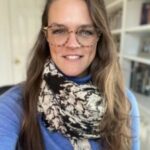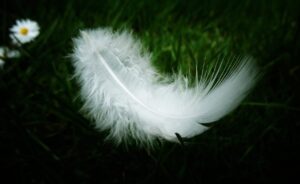By Eloise Marie Repeczky
 Three years ago, on January 7, 2018, my sister, Alicia Smart, suffered a ruptured brain aneurysm at the age of 30. As our first godsend would have it, she was at home with her husband Louis who was able to respond immediately following her seizure. The paramedics subsequently rushed her to the hospital as she was unresponsive. A CT scan then revealed a subarachnoid hemorrhage (blood in the brain released from the ruptured aneurysm). Within 24 hours her medical team successfully performed an endovascular procedure known as “coiling” to repair the bleeding aneurysm, and our family was launched into the “brain aneurysm” world as we frantically tried to understand the consequences and how we could support Alicia and one another.
Three years ago, on January 7, 2018, my sister, Alicia Smart, suffered a ruptured brain aneurysm at the age of 30. As our first godsend would have it, she was at home with her husband Louis who was able to respond immediately following her seizure. The paramedics subsequently rushed her to the hospital as she was unresponsive. A CT scan then revealed a subarachnoid hemorrhage (blood in the brain released from the ruptured aneurysm). Within 24 hours her medical team successfully performed an endovascular procedure known as “coiling” to repair the bleeding aneurysm, and our family was launched into the “brain aneurysm” world as we frantically tried to understand the consequences and how we could support Alicia and one another.
Thrown into the unknown of dealing with a ruptured aneurysm and a recovery that would be challenging, varied, and long, we reached out to our network of family and friends to better understand how we could support her and specifically to see if anyone knew of someone who’d suffered a ruptured brain aneurysm. As Alicia experienced physical and mental challenges over her long recovery, hearing from families and patients who suffered from ruptured brain aneurysms provided a better understanding of the complexity of brain aneurysms and that every situation is different, as is every recovery. These personal testimonies helped Alicia, and us, her support team, acknowledge the incredible patience that is required in the healing process, how temperamental recovery can be, and how we, as a team, could continue to help. This additional layer of emotional support helped us all as aneurysms and the lack of information that is readily available makes it difficult for caretakers and survivors. It was invaluable for us to see head-on some of the challenges Alicia could face and know that we had resources and a network to turn to. We were also incredibly fortunate to have friends help breakdown medical terminology into layman’s terms, and who also assisted in relaying how complicated traumatic brain injury recoveries can be.
 As we began to understand and research aneurysms, we were able to connect some information that could have led to a diagnosis. Several months prior to the rupture, Alicia had complained of severe headaches and a stiff neck. While she had gotten an MRI, the MRI did not provide the vascular detail necessary to identify an aneurysm. Subsequent to her rupture and diagnosis, we leaned on materials from the Brain Aneurysm Foundation as our first resource in understanding the different types of aneurysms and to better understand this silent disease. We were incredibly fortunate in the quick diagnosis, partially due to the seizure, which led to the ER team understanding that the problem was neurological.
As we began to understand and research aneurysms, we were able to connect some information that could have led to a diagnosis. Several months prior to the rupture, Alicia had complained of severe headaches and a stiff neck. While she had gotten an MRI, the MRI did not provide the vascular detail necessary to identify an aneurysm. Subsequent to her rupture and diagnosis, we leaned on materials from the Brain Aneurysm Foundation as our first resource in understanding the different types of aneurysms and to better understand this silent disease. We were incredibly fortunate in the quick diagnosis, partially due to the seizure, which led to the ER team understanding that the problem was neurological.
The Brain Aneurysm Foundation and Bee Foundation have tremendous educational material, which is what prompted me to advocate for September to be designated as Brian Aneurysm Awareness Month in Virginia. I advocated for this in January 2021 and in February we found that the Bill passed. I am hopeful that this will allow others to learn about the impact and signs of brain aneurysms. As mentioned, having resources not just to identify aneurysms prior to their rupture, but also to guide families, caretakers and survivors subsequent to an aneurysm diagnosis can greatly impact recovery and provide critical support to those who need it as they are in uncharted territory, especially in the face of what we know are inevitable feelings of helplessness.
 Since January 7, 2018 Alicia has continued to amaze us with her tremendous strength and resilience. Having been in the neuro ICU for several months, once the vascular side was in the clear, Alicia had to perform OT and PT to regain strength in her body. During her time in the ICU she progressed from a medically induced coma to proving her ability to speak and swallow and use of her arms and legs. Incredibly, her spirit and wit remained. As part of her incredible journey, Alicia gave birth to a little girl, Delphine Davis Smart, in September 2020. We are also grateful that in December 2020, following a routine MRA, she was diagnosed with a second aneurysm and had a subsequent craniotomy and clipping in early February 2021. While her subsequent recovery has taken some time, we are thankful that routine screenings were a part of her diagnosis, and that her team was able to quickly put a plan in place once the second aneurysm was identified.
Since January 7, 2018 Alicia has continued to amaze us with her tremendous strength and resilience. Having been in the neuro ICU for several months, once the vascular side was in the clear, Alicia had to perform OT and PT to regain strength in her body. During her time in the ICU she progressed from a medically induced coma to proving her ability to speak and swallow and use of her arms and legs. Incredibly, her spirit and wit remained. As part of her incredible journey, Alicia gave birth to a little girl, Delphine Davis Smart, in September 2020. We are also grateful that in December 2020, following a routine MRA, she was diagnosed with a second aneurysm and had a subsequent craniotomy and clipping in early February 2021. While her subsequent recovery has taken some time, we are thankful that routine screenings were a part of her diagnosis, and that her team was able to quickly put a plan in place once the second aneurysm was identified.
Over the past three years and since her second diagnosis, my sister has continued to amaze family and friends and demonstrate strength, perseverance, compassion, and kindness. I am also thankful that through outreach we have been able to connect with other families and survivors, serving as a layer of support as others had for us. My hope in sharing our story is for others to have the opportunity to learn about warning signs, as well as learn how to support loved ones who are impacted. The unexpected nature of ruptured brain aneurysms can cause upheavals to personal and professional lives and any information we can provide to help prepare, prevent, and support survivors and caretakers will greatly impact numerous lives.
In watching my sister recover from her ruptured brain aneurysm, and in seeing her prepare and recover from her craniotomy, I have seen how brain aneurysm survivors face greater adversity than many of us will know in our lifetimes. A survivor’s display of strength is nothing short of heroic, especially as from one day to the next their life can be completely altered. As mentioned, brain aneurysms are a silent disease and killer, and I hope that in raising awareness other families will be given the opportunity to protect and help friends and family. All of us who have seen just one survivor’s journey over the past three years are utterly in awe of the courage, patience, resilience and perseverance that it takes.
I truly am so incredibly appreciative that my sister has had a terrific medical team and support system. She is my best friend and I’m so thankful that we have a strong bond from childhood. With the unpredictability of brain aneurysms it is evident that spending time doing what you love with the people you love, is the greatest gift you can give yourself and others!

Eloise Marie Repeczky
Eloise Repeczky is a creative, outdoor adventurer who is deeply appreciative of modern medicine and online brain aneurysm communities. She resides in Middleburg, VA with her husband and their rescue dog Soufflé. They spend their time exploring mountains with their pup and enjoy supporting their local and extended family and community through various advocacy efforts.




